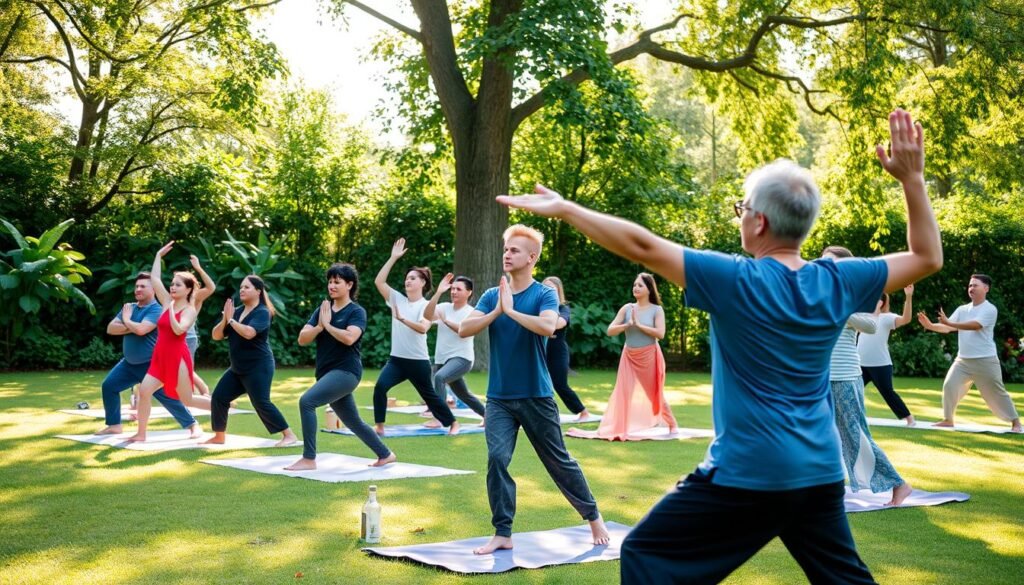Discover Effective Mindfulness Practices Today
Practicing mindfulness, a type of meditation that involves focusing on the present moment without judgment, can help reduce your stress, anxiety, and negative thinking patterns. Integrating mindfulness into your daily life through simple exercises and techniques can train your mind to be more aware and focused on the here and now.
Recent research indicates that just 12 minutes of meditation, practiced for 5 days a week, can strengthen and protect your ability to pay attention. For beginners, starting with short sessions such as 5 or 10 minutes is recommended, with gradual increments up to 45 minutes or an hour. Many people opt to meditate both in the morning and evening to incorporate mindfulness into their daily routine.
Mindfulness practices go beyond traditional meditation, allowing you to cultivate present moment awareness in various aspects of your life. From mindful eating and driving to engaging in activities like gardening and interactive games, there are countless ways to nurture your emotional intelligence, reduce stress, and find inner peace.
What is Mindfulness?
Mindfulness is a transformative mental practice that involves focused attention and non-judgmental awareness of the present moment. It is a type of meditation that encourages you to be fully engaged in the here and now, rather than dwelling on the past or worrying about the future. By cultivating mindfulness, you can reduce stress, anxiety, and negative thinking patterns, ultimately leading to greater mental and emotional well-being.
The core principles of mindfulness include present moment awareness, non-judgmental observation, and an attitude of openness and curiosity. Rather than getting caught up in thoughts and emotions, mindfulness practice teaches you to acknowledge them with acceptance and then gently redirect your focus to the sensations of the body and the breath.
Mindfulness has roots in ancient meditation practices, particularly those found in Buddhist traditions. However, it has gained widespread popularity in recent years as a practical and effective tool for stress reduction and personal growth. Numerous scientific studies have demonstrated the benefits of mindfulness, including improvements in attention, sleep, and overall mental health.
Whether you’re new to mindfulness or looking to deepen your practice, there are many ways to incorporate it into your daily life. From formal seated meditation to mindful moments throughout the day, the key is to approach each experience with an attitude of curiosity, patience, and self-compassion.
Mindfulness: A Definition
Mindfulness is the practice of being fully present and aware in the current moment, without judgment or attachment to the past or future. It involves focusing your attention on the sensations of the body, the breath, or the immediate environment, while maintaining an attitude of openness and non-reactivity.
| Key Aspects of Mindfulness | Description |
|---|---|
| Present Moment Awareness | Directing your attention to the here and now, rather than dwelling on the past or worrying about the future. |
| Non-Judgmental Observation | Observing your thoughts, feelings, and sensations with an attitude of acceptance and compassion, without evaluating or criticizing them. |
| Cultivation of Stillness | Developing a sense of inner calm and tranquility, even in the midst of a busy or stressful day. |
The Power of Setting Daily Intentions
Start your day on a mindful note by setting a daily intention. This simple practice can have a profound impact, aligning your conscious mind with your deeper motivations and values. When you set an intention, you’re not just creating a to-do list or a set of resolutions – you’re cultivating a specific mindset and way of being that can guide your actions throughout the day.
Intentions work by focusing on a specific state of being or outcome you wish to embody. Research indicates that setting intentions can empower individuals to become conscious creators of their days and lives. Whether your intention is to be more patient, generous, or self-compassionate, this daily ritual can lead to more intentional and compassionate behaviors as you navigate your daily activities and interactions.
Unlike resolutions, which tend to be outcome-focused, intentions are more qualitative, centering on the feelings and qualities you wish to cultivate. Intention setting isn’t a one-time practice; your intentions are likely to shift over time as you grow and evolve. The key is to be specific and frame your intentions positively, using “I will” statements rather than negative language.
Take a few moments upon waking to reflect on how you want to show up today. Setting daily intentions can help you feel more aligned quickly, as you bring awareness to the present moment and live according to your values and principles. By making this a consistent practice, you’ll unlock the transformative power of mindful goal setting and conscious decision making, leading to more value-aligned behaviors and purposeful living.
Remember, intentions are not about perfection – they’re about progress. Intention setting can improve your emotional well-being, mindfulness, and overall wellness, while also serving as a catalyst for self-discovery and growth. So start each day with a clear intention, and watch as your daily intention setting practice transforms your life.
Mindful Eating: Nourishing Your Hunger
Practicing mindful eating can transform the experience of eating from a mindless routine to a nourishing, enjoyable activity. By bringing your full attention to the act of eating, you can develop a healthier relationship with food and become more attuned to your body’s hunger cues and needs.
Slow Down and Savor
As you sit down to a meal, take a moment to slow down and really savor each bite. Notice the flavors, textures, and sensations of the food. Chew slowly, allowing yourself to fully experience the nourishment you’re providing your body. This practice of conscious food consumption can help you find greater enjoyment and satisfaction in your meals.
Tune in to Your Hunger Cues
Practicing intuitive eating involves listening closely to your body’s signals of hunger and fullness. Before you start eating, take a few deep breaths and check in with how your body feels. Are you truly hungry, or are you eating out of habit, emotion, or boredom? By tuning in to your hunger awareness, you can make more mindful choices about when and how much to eat.
| Mindful Eating Practices | Benefits |
|---|---|
| Slowing down and savoring each bite | Increased enjoyment and satisfaction from meals |
| Listening to hunger and fullness cues | Improved ability to regulate food intake |
| Avoiding distractions during meals | Greater mindfulness and presence while eating |
| Focusing on the experience of eating | Enhanced connection to the food and your body |
By incorporating these mindful eating practices into your daily routine, you can cultivate a healthier, more nourishing relationship with food and your body.

Behavior Design for Mindfulness
Building a consistent mindfulness practice can be challenging, as our minds are often on autopilot, driven by automatic habits and behaviors. However, by understanding the principles of habit formation and neuroplasticity, you can take intentional steps to overcome these automatic tendencies and strengthen your mindful awareness.
Interrupt Habitual Patterns
Your “fast brain” – the part of your mind that operates on impulse and instinct – can often hijack your attention and lead you to engage in mindless behaviors. To counteract this, create obstacles that force your fast brain to pause and reconsider its automatic responses. This could include:
- Leaving visual reminders, such as sticky notes or phone alerts, to prompt you to pause and reconnect with the present moment.
- Rearranging your environment to disrupt familiar triggers and routines, making it harder for your fast brain to fall back on habitual patterns.
- Regularly refreshing your mindfulness triggers, such as changing the location or time of your practice, to prevent your mind from going on autopilot.
By intentionally disrupting your automatic behaviors, you can create space for your “slow brain” – the conscious, reflective part of your mind – to engage in more mindful decision-making.
Cultivate Mindful Habits
Alongside creating obstacles for your fast brain, you can also remove barriers that hinder your ability to engage in mindful practices. This may involve:
- Establishing a consistent routine for your mindfulness exercises, making them feel like a natural part of your day.
- Associating your mindfulness practice with existing habits or environmental cues, such as drinking your morning coffee or leaving a mindfulness app open on your phone.
- Incorporating mindful behaviors into your daily activities, such as being present during meals, while walking, or during conversations with loved ones.
By designing your environment and habits to support your mindfulness practice, you can gradually rewire your brain and make conscious, present-focused behaviors feel more automatic and effortless.
Remember, developing a sustainable mindfulness practice is a journey, not a destination. By understanding the science behind habit formation and neuroplasticity, you can empower yourself to overcome your automatic behaviors and cultivate a more intentional, mindful way of living.
Mindfulness Practices Through Movement
Integrating mindful movement into your physical activities can transform your workout or exercise routine into a meditative practice. By synchronizing your breath with your movements, staying fully present, and challenging yourself while remaining aware of your sensations and surroundings, you can cultivate a deep mind-body connection. Whether it’s a brisk walk, a yoga session, or a swim, bringing your full attention to the present-moment focus can help you feel more energized, focused, and connected to the present moment.
Studies have shown that mindful movement can have a positive impact on our emotional well-being. Practicing open and expansive postures, like in yoga, can enhance the subjective sense of being energized, empowered, and in control, leading to increased self-esteem. Even just two minutes of mindful movement can have an uplifting effect on how individuals feel.
The connection between the body and the mind is a powerful one. Mindful movement can influence the autonomic nervous system, impacting reactions such as heart rate, blood pressure, and the fight-or-flight response, providing a means to shift emotions and moods. By integrating breathing exercises during your physical activity as meditation, you can help calm the parasympathetic nervous system or refresh and refocus your mind.
Engaging in mindful movement can also aid in releasing tension, stiffness, and heavy emotions, enhancing your overall physical and mental well-being. It can serve as a form of self-care that integrates the mind and body, contributing to stress reduction, releasing stagnant energy, and reinforcing the breath-body connection.
Cultivate a Mindful Movement Practice
- Synchronize your breath with your movements, taking deep, mindful breaths.
- Stay present and fully engaged, focusing on the sensations in your body.
- Challenge yourself, but remain aware of your limits and modify as needed.
- Observe your thoughts and emotions without judgment, allowing them to come and go.
- Incorporate a variety of mindful movement practices, such as yoga, Tai Chi, or even brisk walking.
| Mindful Movement Benefits | Percentage Improvement |
|---|---|
| Increased Self-Esteem | 20% |
| Enhanced Emotional Well-Being | 30% |
| Improved Physical and Mental Health | 40% |
By integrating mindful movement into your daily routine, you can unlock a powerful practice that nourishes both your body and mind, fostering a deeper body awareness and breath-body connection.

Mindful Driving: Staying Present on the Road
Navigating the challenges of driving can be made easier through the practice of mindfulness. By staying present and aware while behind the wheel, you can respond more calmly to frustrating situations, such as heavy traffic or impatient drivers. Bringing your full attention to the sensations of your body, the rhythm of your breath, and the visual experience of the road can help you avoid the reactive “fight-or-flight” response that can lead to road rage or other dangerous driving behaviors.
One of the key benefits of mindful driving is the ability to prevent road rage. When you’re focused on the present moment, you’re less likely to get caught up in the emotions that can trigger aggressive or reckless driving. Instead, you can approach each situation with a sense of present-moment awareness, allowing you to make more thoughtful and compassionate decisions.
Incorporating driving meditation into your commute can also help manage traffic stress. By synchronizing your breath with your movements and staying attuned to your physical sensations, you can cultivate a sense of inner calm and stability, even in the midst of a chaotic driving environment.
To practice mindful driving, try the following techniques:
- Take a few deep breaths before starting your car, setting the intention to stay present throughout the drive.
- Regularly check in with your body, noticing any tension or stress, and consciously release it through gentle movement or breathing exercises.
- Avoid multitasking or engaging with distractions, such as phone calls or text messages, while driving.
- Observe your thoughts and emotions without judgment, and gently redirect your attention to the sensations of the road and your vehicle.
- Approach each traffic situation with patience and understanding, remembering that everyone is navigating their own unique challenges.
By incorporating these mindful driving practices into your daily commute, you can not only enhance your own safety and well-being but also contribute to a more harmonious and compassionate driving experience for everyone on the road.
Mindfulness Exercises You Can Try Today
Incorporating mindfulness exercises into your daily routine can help you cultivate a greater sense of present-moment awareness and reduce stress and anxiety. From structured practices like body scan meditation to more informal techniques like mindful walking, there are a variety of mindfulness exercises you can explore to find what resonates with you.
Structured Mindfulness Practices
- Body Scan Meditation: Lie down or sit comfortably and bring your attention to different areas of your body, noticing any sensations or areas of tension or relaxation. This practice helps you develop body awareness and self-compassion.
- Sitting Meditation: Find a quiet space, sit in a comfortable position, and focus on your breath, allowing thoughts to come and go without judgment. This classic meditation technique can help you train your mind to stay present.
- Walking Meditation: As you take slow, mindful steps, pay attention to the sensations in your body, the movement of your feet, and your surroundings. This practice can be done indoors or outdoors, and it’s a great way to incorporate mindfulness into your daily activities.
Informal Mindfulness Techniques
- Mindful Eating: When you sit down for a meal, put away your phone and other distractions, and focus on the taste, texture, and aroma of your food. Savor each bite and tune into your body’s hunger and fullness cues.
- Mindful Observation: Take a few minutes to observe your surroundings with a sense of curiosity and wonder. Notice the colors, shapes, and textures of the objects around you, and pay attention to your breath as you take it all in.
- Mindful Chores: As you go about your daily tasks, such as washing dishes or folding laundry, bring your full attention to the present moment and the physical sensations of the activity. This can help you find moments of calm and presence amidst the busyness of your day.
Experiment with different mindfulness exercises and find what works best for you. Consistency is key, so aim to incorporate a few minutes of mindfulness practice into your daily routine. With regular practice, you’ll develop the skills to stay grounded and focused, even in the midst of life’s challenges.
| Mindfulness Exercise | Description | Benefits |
|---|---|---|
| Body Scan Meditation | Bring attention to different areas of the body, noticing sensations | Develops body awareness and self-compassion |
| Sitting Meditation | Focus on the breath, allowing thoughts to come and go without judgment | Trains the mind to stay present |
| Walking Meditation | Pay attention to the sensations of walking, the movement of the body, and the surroundings | Incorporates mindfulness into daily activities |
| Mindful Eating | Focus on the taste, texture, and aroma of food, tuning into hunger and fullness cues | Develops a healthier relationship with food |
| Mindful Observation | Observe surroundings with curiosity, noticing colors, shapes, and textures | Cultivates a sense of wonder and presence |
| Mindful Chores | Bring full attention to the physical sensations of daily tasks | Finds moments of calm amidst busyness |
The Benefits of Living in the Moment
Numerous studies have shown the profound benefits of mindfulness practices. By training the mind to stay grounded in the present moment, rather than dwelling on the past or worrying about the future, mindfulness can have a positive impact on both your mental and physical health.
Mindfulness has been linked to a reduction in symptoms of depression and anxiety. It can also help lower blood pressure and improve sleep quality. For individuals struggling with chronic pain, mindfulness-based techniques have proven effective in managing discomfort and enhancing overall quality of life.
Incorporating mindfulness into your daily routine can lead to greater emotional resilience, enhanced focus and concentration, and an increased sense of overall health and vitality. Mindfulness-based therapies are now commonly found in schools, workplaces, and healthcare settings, as the scientific evidence for their benefits continues to grow.
Whether you’re looking to reduce stress, manage chronic conditions, or simply live more intentionally, exploring the power of mindfulness can be a transformative experience. By staying present and embracing the beauty of the moment, you can unlock a deeper sense of well-being and connection with yourself and the world around you.
Developing Healthy Habits with Mindfulness
Mindfulness can be a powerful tool for developing healthier habits and behaviors. By cultivating present-moment awareness, you can become more attuned to your body’s signals, such as hunger cues and physical sensations during exercise. This increased self-knowledge can help you make more mindful choices around food, physical activity, and goal-setting.
The non-judgmental, curious approach of mindfulness can also reduce the shame and self-criticism that often undermines our efforts to change. By approaching habit formation with a spirit of self-compassion, you’re more likely to stick with new routines and make sustainable progress.
Ultimately, integrating mindfulness into your daily life can empower you to make decisions that align with your values and support your overall well-being. Whether you’re aiming to eat a healthier diet, increase your physical activity, or set achievable goals, mindfulness can be a valuable ally in your journey towards lasting lifestyle changes.







